-
eighth week
I can’t believe that time has flown by so quickly! I’m now wrapping up the final week of my summer internship at PHRII, which has been an incredibly meaningful and valuable learning experience.
Monday through Wednesday consisted of running more miRNA isolations. So far, miRNA have been proving incredibly finicky to work with, so it’s been very difficult to reproduce our RNA quality and yield results from day to day and between operators.
Wednesday afternoon, all the interns had their final presentations. It was so lovely to hear from everyone and about the progress they’ve made. Even though we’ve all talked about our projects colloquially, I really enjoyed learning about the work each person accomplished in detail.
Thursday, Samhita and I took the day off to visit Sri Rangapatna with her grandma and younger brother, Supash. Our intinerary began at the Srirangapatna Temple, which had a beautiful, ornate exterior.


Our next stop was Tipu Sultan’s Summer Palace, followed by Gumbaz, the burial place of Tipu Sultan and his family members. It was fascinating to learn more about the history of Tipu Sultan, who ruled Mysore during repeated invasions by the British. The palace grounds were filled with lush greenery, and the interior was decorated with meticulous wall details slightly faded from years of exposure. The pencil-sketched drawings of Tipu Sultan and his sons as well as the relics of clothing and weapons were also quite interesting to browse.


Gumbaz 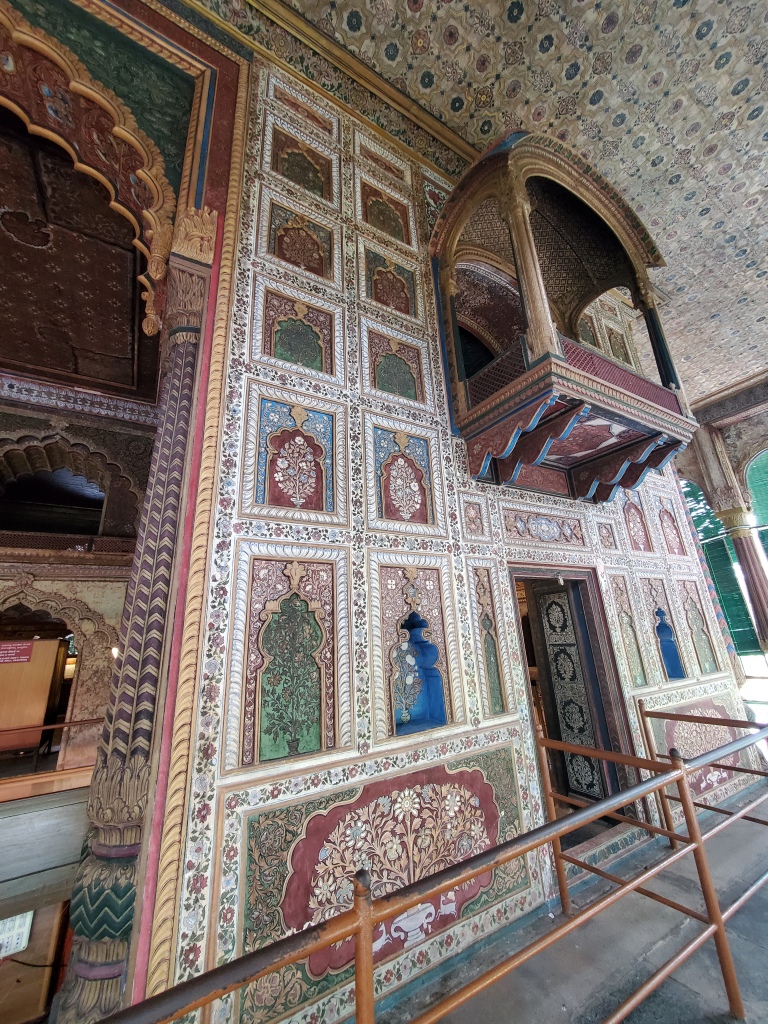

Afterwards, we visited the KRS Dam. Due to increased rainfall, the dam was now open, and the sight and sounds of the water gushing through was deafening.

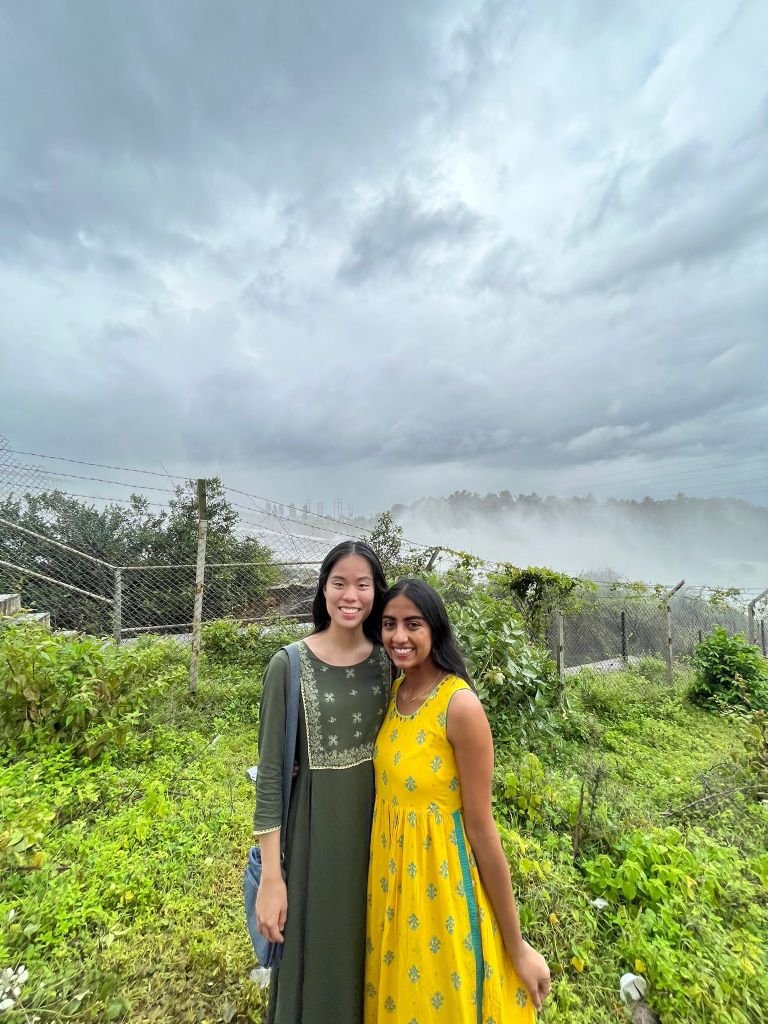
We then headed to Venugopala Swamy Temple. This was definitely my favorite spot that we visited, as the temple was beautifully preserved. Even though it was very windy, it was so peaceful to walk through the temple and take time to observe the intricate stone details. Samhita and Supash were also so kind to explain the meanings and backstory behind each deity we saw.


Our final destination was Brindavan Gardens. Despite the looming storm clouds and drizzling rain, it was still great to walk through and see the fountains.

Saturday, I gave my final presentation to the PHRII staff, since we had run out of time on Wednesday. I was able to receive a lot of helpful feedback from Dr. Karl and Dr. Kiran, which will definitely help me to improve in future research-oriented presentations!

Sunday, Nikhita, Samhita, and I left for Kabini Tiger Reserve along with Supash and Samhita’s cousin, Deeksha.


During our first safari later that evening, we caught sight of quite a few wildlife, including elephants, spotted deer, gaur, and monkeys. The highlight was seeing a sleeping tiger in the brush! Even though it was camouflaged well, we were able to see its tail briefly wave in the air.



The next day, we woke up bright and early at 5:30 for our morning safari, during which we saw a jaguar sleeping in a tree! Since our safari guide had brought along a pair of binoculars, we were able to get a much clearer view. It was so majestic! Even though we saw fewer animals that we would have if we had gone to the zoo, it was much more rewarding to see the wildlife in their natural habitat.




And just like that, it’s over. I can’t believe that eight weeks have passed by so quickly. I’m so grateful for my time with PHRII, the valuable lessons I’ve learned, and the incredibly dedicated and passionate staff and interns I’ve met this summer. Thank you again to Dr. Purnima and Dr. Karl for facilitating this internship and giving me such valuable feedback throughout this entire process; this project wouldn’t have been possible without all your support! Thank you to Anisa and Kavitha for your endless support and mentorship in the lab, Lakshmi, and Siddhu for your hospitality, and Teju, Mrs. Jay, Dr. Kiran, and Dr. Vijaya for making this experience an incredibly meaningful one!!
-
seventh week
Monday 7.4
THE LIZARDS HAVE RETURNED.
This week, Anisa and I continued to implement various miRNA isolation protocols in hopes of improving our miRNA quality to reach the 2.0-2.2 benchmark for our A260/280 and A260/230 values.
On Monday, Nikhita, Samhita, and I went to A2B for dinner, where I ordered their plain dosa.

Tuesday 7.5.2022
Today, Anisa and I each ran the kit protocol according to Dr. Gopinath’s suggestions, omitting DNAse I digestion and modifying the elution step with nuclease-free water heated to 60 degrees C. Since moving most of the lab procedures to PHRII, it has greatly reduced our need to go back and forth between JSS Medical College and PHRII, but there are still a few equipment limitations.
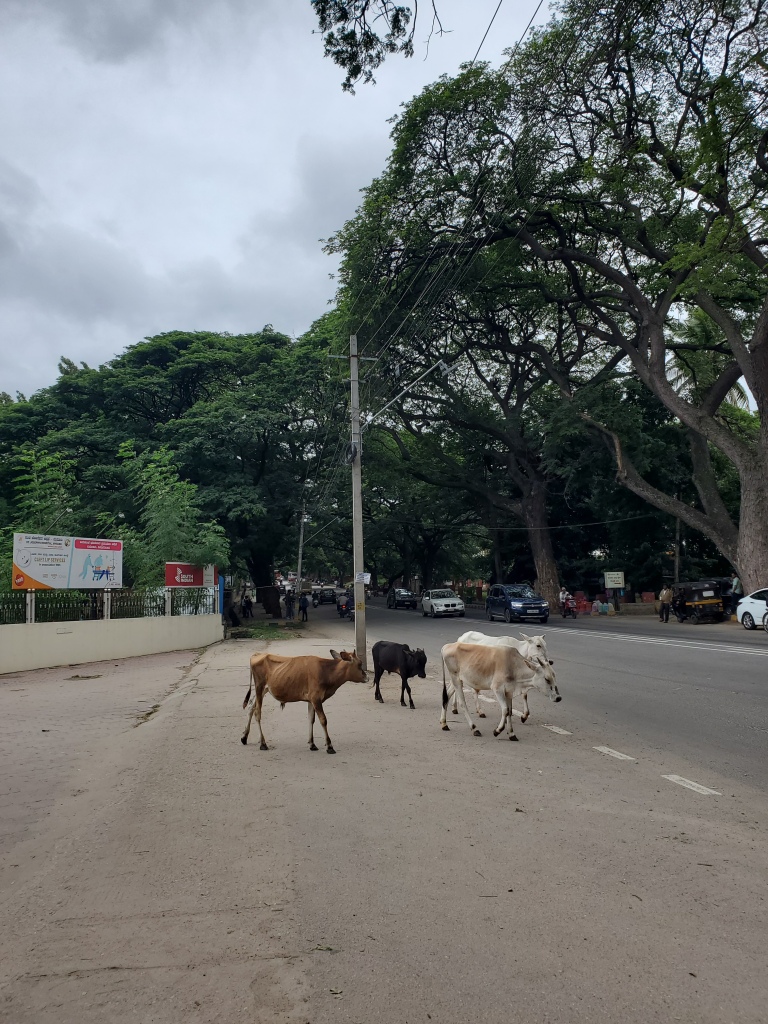
some cows I saw while waiting for an auto Wednesday 7.6.2022
Today, I accompanied Samhita for five of her interviews among the rural ASHA workers and Anganwadi workers. Since her interview consists of multiple Likert scale questions, I was able to follow along with an English translation of her questionnaire. Between interviews, we stopped for some onion pakoras!
Interesting enough, Samhita’s last few interviews were conducted at the same village that I had previously visited with Nimitha and Divya weeks ago! Since I was not able to comprehend much of their interviews since they were all conducted in Kannada and recorded on the spot, it was really helpful that Samhita’s interviews included more visual aids, which made for a more informative experience.


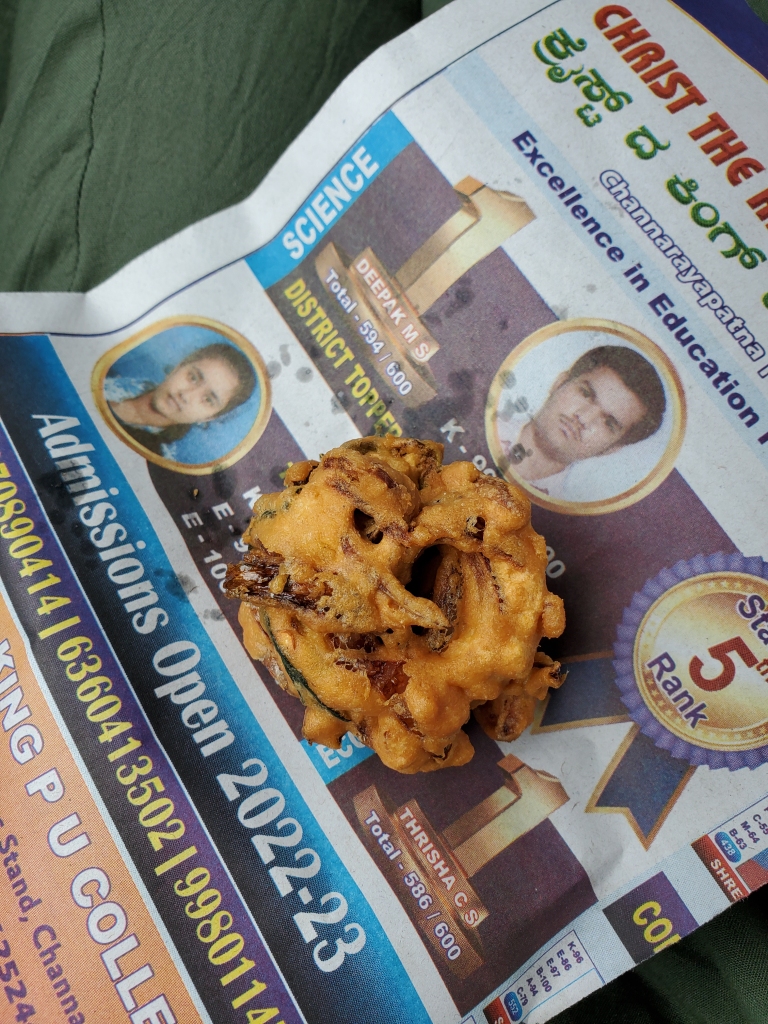
onion pakora 
Anganwadi Center Thursday 7.7.2022
Today, I ran four miRNA isolations: two following a modified TRIzol protocol in duplicates while the other two included an additional kit washing step after isolation using TRIzol. This turned out to be a whole-day affair, as each isolation involves various lengthy incubation and centrifuge steps.
Later that evening, Anisa and I met with Dr. Zhou, my lab PI back in the United States, and Tasha, my lab manager in the Zhou lab, to discuss primer design and RT-qPCR SOP’s and gain some clarity on the results we’ve obtained relating to RNA yield and quality. It was really wonderful seeing them both again, and I can’t wait to return to the US to implement what I’ve learned here for our breast cancer miRNA project!
Friday 7.8.2022
Anisa and I returned to JSS today to record the Nanodrop readings for the miRNA samples isolated yesterday. I rode on the back of her two-wheeler, which was initially terrifying at first but turned out to be quite fun after a few minutes.

The rest of the day was spent validating primer sequences and researching additional miRNA isolation modifications we could make to hopefully improve our miRNA quality.
Saturday 7.9.2022
In the evening, Nikhita, Samhita, and I went to watch the Minions movie. It was only available in English in 3D! One thing I found interesting was that movies here in India always include an intermission, which allow for people to replenish snacks. The movie was definitely nostalgic, having grown up watching the Despicable Me movies.



-
sixth week
MONDAY:
We began today with a staff meeting at PHRII, where each of the interns gave a brief summary of their progress so far and discussed the challenges and successes we faced. Dr. Kiran and Dr. Vijaya also shared about the recent cases they had seen in the clinic. Dr. Purnima and Dr. Karl were able to give some really meaningful feedback, and here are a few of the broader takeaways I noted:
- Utilize your network effectively. If other people have expertise in fields you do not, seek them out! Don’t waste time reinventing the wheel.
- Know when to cut your losses. At some point, it becomes necessary to start fresh than keep on trying to fix a deeply broken system. Even though it’s difficult to sacrifice the time and effort committed up to this point, it’s often necessary to pivot your attention in order to develop a system that will repeatedly work.
- The importance of participatory action research. In academia, we have an ethical responsibility to give feedback to the communities when we conduct research. Our role is not just to go in, collect data and leave to present our findings in fancy conferences, returning when we need more data. Instead, we have to consider what comes after, collaboratively designing interventions along with the community to directly contribute to correcting the issues and deficiencies we’ve encountered during the research process.
Later that day, Anisa and I headed to JSS to conduct Nanodrop readings of the RNA samples we isolated using the acetone and QIAzol protocol. I spent the rest of the day combing through PubMed to find suitable primer sequences for the target miRNA we’ve chosen to study for this project.
TUESDAY
I spent all day at JSS Medical College to conduct the RNA isolation protocol with an initial acetone wash using the QIAgen Advanced Kit protocol. This will serve as a comparison to the RNA sample isolated last week using the QIAgen original kit protocol.
WEDNESDAY
Today, Anisa, Medha, and I went to the Council of Scientific and Industrial Research-Central Food Technological Research Institute (CSIR-CFTRI). There, we met with Sreeram, a PhD student working in the lab of Dr. Gopinath M S, to investigate plant non-coding RNAs in wound healing and skin diseases. Thanks to this collaboration organized by Dr. Subba Rao, they graciously invited us to visit their lab and supplied materials for us to conduct RT-qPCR with a few of our miRNA samples.
This meeting was so helpful!! After repeating miRNA isolations with little success or improvement in our RNA quality for the past few weeks, it had become very discouraging, but it was genuinely so refreshing to be able to discuss our project and troubleshoot our setbacks with someone familiar with working with miRNA. Sreeram went through each of the modifications we had already conducted, offered suggestions for a new TRIzol protocol, and explained the rationale behind each step; why certain centrifuge steps are carried out at lower temperatures or higher speeds, why we use 70% EtOH instead of other concentrations, etc. I’m very appreciative of the time he took out of his day and undoubtedly busy schedule to meet with us; this project is finally looking up!
THURSDAY
Anisa and I went to JSS again today to conduct miRNA isolation, implementing the suggestions that Sreeram gave us yesterday. On the way back to PHRII, we noticed huge crowds gathered along the road with herds of sheep. Anisa explained to me that this was due to Bakrid, an upcoming Muslim festival where sheep and goats are sacrificed as qurbani. After the ritual, the meat is divided into three parts and distributed among family, friends and neighbors, and the needy.

FRIDAY
We went over to CFTRI again today to meet with Dr. Gopinath to discuss next steps for our project, which will include replicating the TRIzol RNA isolation protocol. Anisa and I will each run the isolation in duplicates, as will Sreeram, so we can all compare the reproducibility of this SOP.
During this visit, I also had my first two-wheeler ride! Sandwiched between Medha and Anisa, it was exhilarating and terrifying at the same time.



After work, Dr. Kiran and her husband invited all of the interns to SAPA bakery. Their menu changes every week, so I was able to enjoy entirely new pastries this time around!

Nimitha and Divya!! 
mango cheesecake + Earl Grey tea WEEKEND
Saturday morning, Nikhita, Samhita, and I set off on our weekend trip to Coorg! Our first stop was Bylakuppe, a Tibetan settlement home to the Namdroling Monastery Golden Temple. The inside of the temple was stunning and the sheer height of the Buddha statues was breathtaking.


After, we visited a coffee plantation, as Coorg is very well-known for their coffee and chocolate exports. On our tour, we learned about the various stages of the coffee bean planting and harvesting process and even had the opportunity to sample some coffee and chocolate!! In the gift shop afterwards, Nikhita, Samhita, and I each bought a block of chocolate for 200 rupees, definitely a steal!


We then arrived at Raja’s Seat, which translates to “Seat of the Kings”. Most of the view was obscured by fog, and our umbrellas barely held up in the wind and pouring rain!

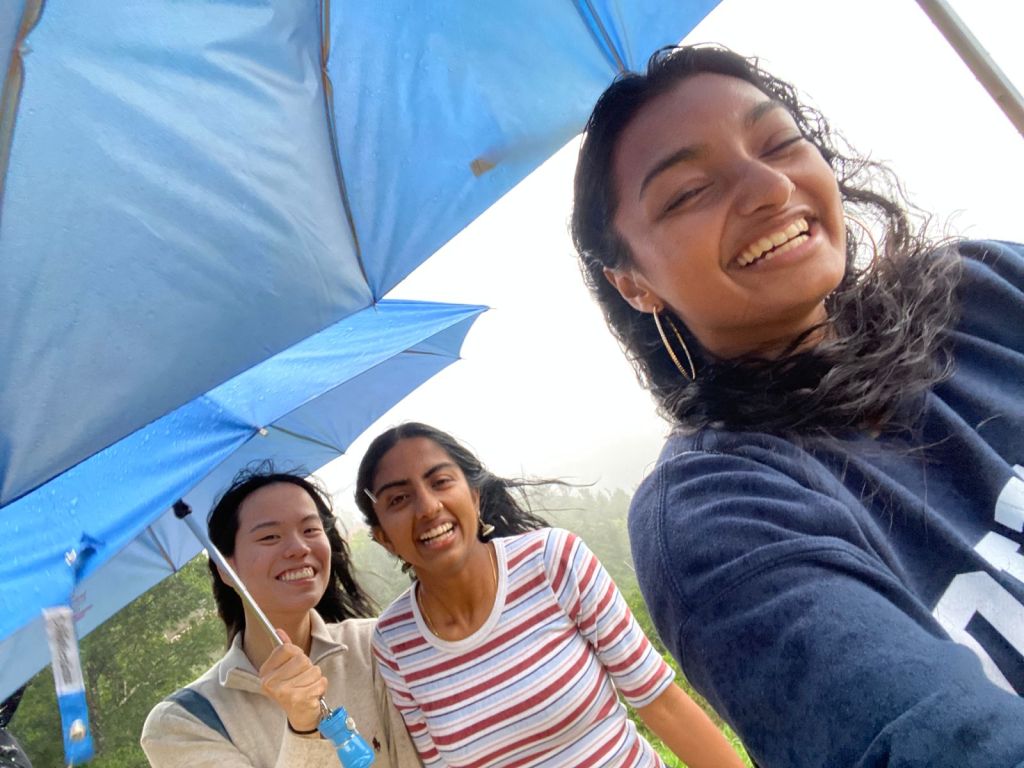


For dinner, we visited a restaurant serving local Kodava cuisine and ordered the ubiquitous Coorg Pandi (pork) Curry. It was easily the spiciest meal I’ve had in India.

The next morning, we left from our homestay at Cauvery Suites for a 3-hour jeep safari in Mandalpatti. The views of the mountains were breathtaking and the jeep ride itself was exhilarating as we traveled along some extremely bumpy roads.

Abbi Falls 
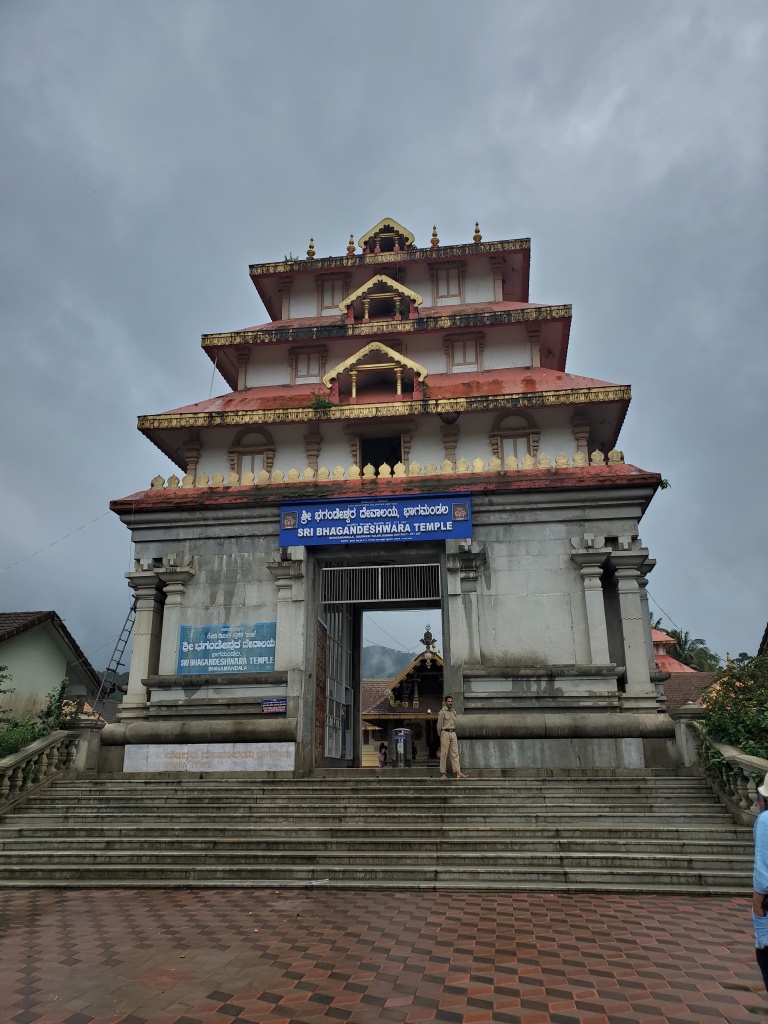
Sri Bhangandeshwara Temple 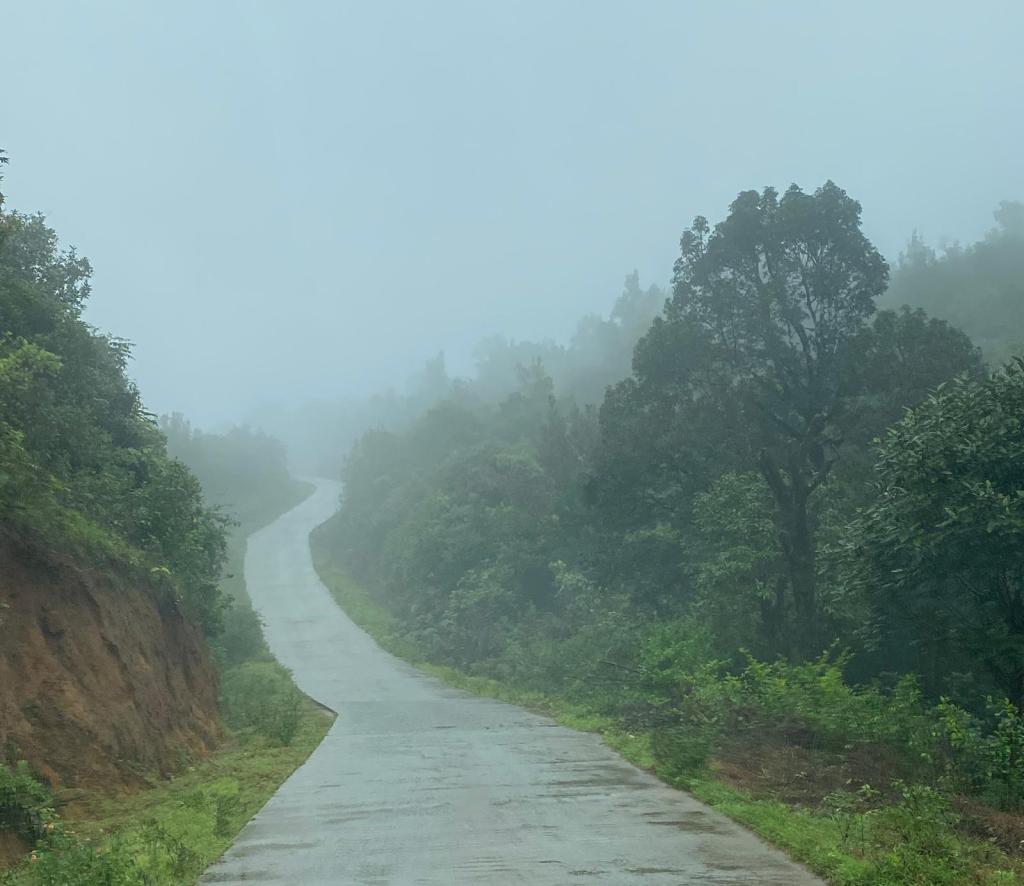
After visiting Abbi Falls, we drove to Sri Bhagandeshwara Temple, where we were stopped outside by a group of college-aged boys for pictures. It was slightly unusual since most of the people that I’ve passed on the streets in India don’t give me a second glance as a foreigner, and the majority of those who’ve stopped and stared are typically younger, school-aged children. Thankfully, Nikhita and Samhita were there with me too, and it turned out to be a very memorable and hilarious experience.
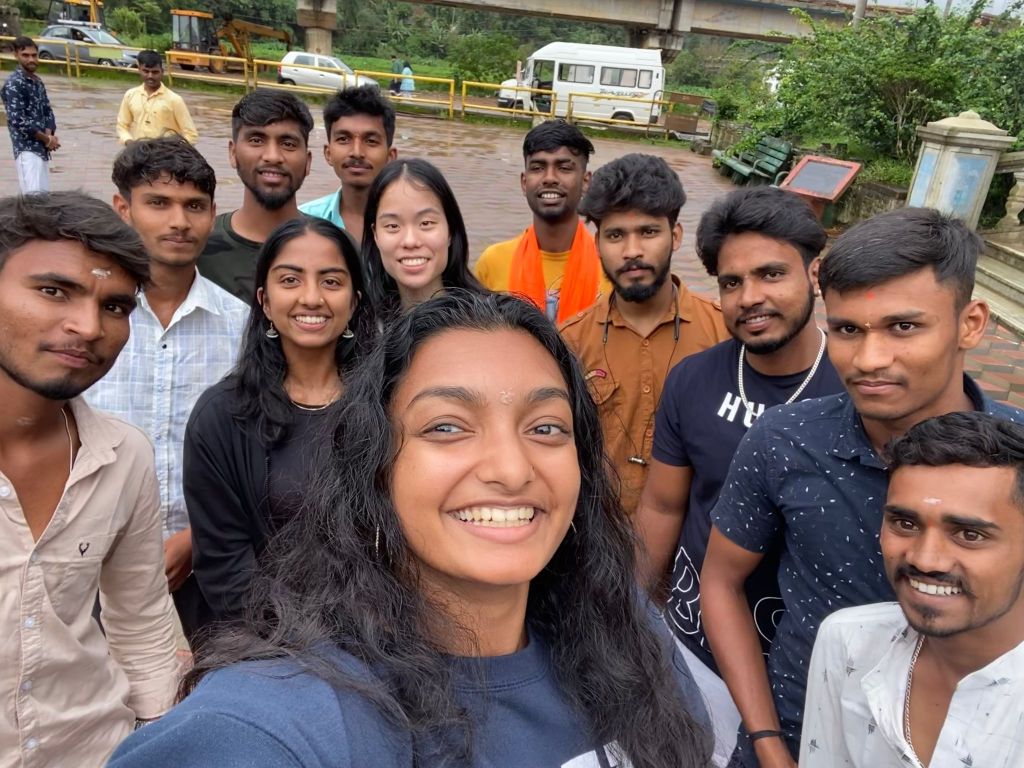
The last destination we visited was Talakaveri, considered to the source of the river Kaveri. By the time we arrived, it was pouring, and the steps to the temple were completely flooded with rain. Nevertheless, we decided to trek on, getting completely soaked in the process. When we returned to the car, we were all delirious from the rain and very thankful to have our Jim Jams to snack on during the ride back to Mysore.
Overall, I would highly recommend Coorg as a weekend trip! Props to Teju for coordinating the logistics!! It was incredibly fun, and we definitely came out of it with so many amazing memories.
-
fifth week
This week mainly consisted of attending the Cytogenetics and MCB Techniques workshop at JSS Hospital. With Prime Minister Modi arriving on Monday for International Yoga Day, BJP banners, flags, and massive billboards lined the streets touting the primer minister’s “Yoga for Humanity” campaign.



As a result, road closures were frequent today with a large police presence to direct traffic. For instance, my auto ride back to PHRI from JSS Hospital took 30 minutes instead of the usual 15.
Tuesday evening, I went with Medha, a recent MD graduate from Bangalore who is also attending the Cytogenetics workshop, to SAPA. This bakery was started by a German woman who trained in French bakeries and cafes throughout India and now lives in Mysore with her family. They’re most well-known for their sourdough, but their other pastries were just as delightful. Medha and I each ordered their house-made ginger ale and shared the honey walnut rosemary sourdough loaf, tomato and olive panini, and chocolate walnut babka. Each pastry tasted so fresh and the ambiance of the place was incredibly welcoming and inviting. The quality of ingredients and balance of flavors were so well-executed, and it really made me miss baking at home.

Wednesday, we had a lecture by Dr. Pooja Aggarwal on molecular diagnostic tools and genetic testing in the field of clinical medicine. Out of all the talks today, I found this one the most intriguing because of its applications for the miRNA research I’m currently conducting. With my study examining miRNA expression in cervical cancer progression, the ultimate goal is to develop a biomarker panel that will identify which miRNA correspond with certain hallmarks of cervical cancer. Using this panel, diagnostic tests can be developed that will only require blood samples to effectively screen for cervical cancer, compared to the current methods of VIA (Visual Inspection with Acetic Acid), VILI (Visual Inspection with Lugol’s Iodine), pap smears or pelvic exams, all of which are either prone to physician error, perceived as invasive or taboo, or cause heighted discomfort to patients. In her lecture, Dr. Pooja explained the science behind the variety of biotech devices we often take for granted, ranging from breathalyzers, at-home COVID and pregnancy tests, and smart watch functions to analyze our heart rate and O2 saturation. One of the most exciting advancements she discussed was this concept of “lab on a chip,” which promises to bring common laboratory techniques to rural and underserved communities where access to traditional screening and diagnosis methods is much more limited. Even though an intervention like this will likely be years down the line, it’s still incredibly exciting to see how intersections between tech and medicine have the potential to drastically improve health outcomes.
After the workshop, a few of the visiting students and I went to St. Philomena’s Church, one of the largest cathedrals in India. The architecture and detail were breathtaking, and they were even holding a Kannada service inside when we visited!




On Thursday, we began the workshop with a lecture by Dr. Vinay Kumar Rao on the fundamentals of confocal microscopy. For me, microscopes always seemed as ubiquitous pieces of equipment in wet labs that magnify slides by thousands-fold, but even as I used them day after day to identify the estrous stages of mice in Dr. Zhou’s lab, I never stopped to think about how they actually work. Dr. Vinay began his lecture with images of neurons and cytokines captured by confocal microscopes that were frankly breathtaking. It was really one of those “wow” moments that inspire wonder and remind you of just how beautiful and complex our bodies are. Sometimes, research becomes so mundane when you’re stuck in the grind of trying to standardize protocols or master pipetting, but it’s truly moments like those that instill a greater sense of purpose to this line of work. During the presentation, Dr. Vinay also brought up the principles of light emission and absorption that allow proteins to fluoresce and be captured under a confocal microscope. It was fascinating to see these concepts I learned in gen chem applied to lab tech.
After the workshop, I went to Pataka with a few of the other students from the workshop. Since it was listed on the PHRI guide as a place for “safe, good, chaat”, I decided that if there would be any instance on this trip where I ventured out into the world of Indian street food, now would be it. There, we ordered pani puri, bhel puri, dahl papdi chaat and palak pakoda chaat, spiralized potato on a stick with piri piri seasoning. My favorite out of all the dishes we tried was the palak pakoda chaat, which consisted of fried spinach leaves mixed with curd, red onions, cilantro, and a variety of spices. The yogurt really helped to neutralize some of the heat, and all the flavors complemented each other nicely. We finished the night with some ice cream from Corner House, which was amazing as well.
Friday was the last day of the workshop. It was bittersweet saying goodbye to all the workshop participants and professors. Isn’t it strange how there’s some people that you can know for years but remain little more than mere acquaintances, and then there’s others that you meet only for a few fleeting days, but it feels like you’ve known each other forever? Maybe it’s the novelty of it all or the fact that spending 7 hours a day in a hospital lab with other people just as clueless as you are serves as the perfect bonding experience, but I’m really going to miss the people I’ve met this week when this workshop ends. The workshop was not only a valuable opportunity for me to learn about basic MCB lab techniques, but it also provided firsthand insight into higher education in India. The professors, faculty, and PhD students at JSS who organized the workshop did an incredible job in planning the logistics, and everyone was so kind and willing to answer questions and offer personal and professional advice. I don’t know if I’ll ever see any of them again, but I’m very grateful for the time we had together.



Over the weekend, Nikhita and I went to tour the inside of the Mysore Palace. It was stunning to see the remarkable detail in the paintings and architecture, and I still can’t wrap my head around the fact that the hallways we roamed used to be the living spaces of the Mysore royal family.



We spent the rest of the day touring Jaganmohan Palace and shopping at Forum City Centre Mall, ending the night by watching the palace lights with Dr. Purnima and her family.

-
fourth week
MONDAY
Today, we went to JSS again to conduct cDNA synthesis. Unfortunately, we were unable to run the RT-qPCR today, so it looks like we’ll be returning tomorrow.
On a happier note, I’ve received more responses for physician shadowing!
Since I’ve had some downtime due to scheduling conflicts with Medha to run the miRNA project, I’ve been dedicating most of my time to reaching out to physicians in AZ to coordinate shadowing opportunities for when I return to US or learning how to code in Python from Professor Dicken’s CSC110 website.
I was looking at my sent folder and realized that the first email I sent requesting physician shadowing was nearly two weeks ago. So far, the only acceptances I’ve received are from personal phone contacts that I know in real-life. It really brings into perspective how valuable networking and connections are. Even with these existing connections, it’s already so difficult to get a response just by cold-emailing people. Even then, I’m fortunate enough that as a student at the U of A, I have access to resources like pre-health advisors and affiliated hospitals that I can reach out to. For non-traditional students or even just people without these options, I imagine it would be so much more difficult. There really should be some centralized system where pre-med students can directly reach out to physicians without having to get caught up in the messy logistics of it all.
How I think about bartering has also shifted. I used to be incredibly embarrassed when my mom would haggle with street vendors or at yard sales for lower prices. To me, it insinuated that we couldn’t afford to pay full price for commodities. There’s this stereotype associated with Chinese Americans that we’re extremely cheap and always on the hunt for a good deal, and bartering only seemed to reinforce that narrative. It’s funny that now that I’m paying out of my own pocket how much more economical it seems. Bartering isn’t desperate, it’s smart. It takes a lot of skill to negotiate to make both parties happy, read nonverbal cues, and know when to compromise. Quite frankly, it’s a valuable life skill to have. There’s all this talk about transferrable experiences to build your resume, but there’s plenty of real-life endeavors like bartering that serve a purpose too.
TUESDAY
This morning, I was able to observe a mock interview for Nikhita’s project. Everyone was positioned around the couches: 3 counselors: 1 interviewer (Ambika), 1 participant (Fazila), and 1 notetaker (Rani). I was surprised that Fazila was providing very detailed responses to the questions, and that the setup was so similar to the real interviews. As Ambika asked the questions, there was a lot of back and forth, with Fazila even posing clarifying questions like a real participant would. The entire process took around 45 minutes. I assumed it would be like a table read for screenwriting scripts, but it makes sense that they would do this to be better prepared for the interviews they’ll carry out in the upcoming weeks.
After the mock, they conducted a debrief, the main focus of which was making sure that the intention behind the questions are clearly communicated and understood so that the participant responses match what the questions are intending to probe for. If there was any mismatch, they worked on rephrasing questions. For instance, there was one question that inquired about social taboos regarding diabetes, but the response discussed more along the lines of general diabetes knowledge in the community. As such, Dr. Kiran suggested changing the wording so that the responses they received would probe more for stigma rather than knowledge.
During the debrief, they also acknowledged certain limitations of the project. Surprisingly, there’s no knowledge of whether the patients they are interviewing have T1 or T2 diabetes. According to Dr. Kiran, patients often won’t even know themselves, and the primary health centers and clinics they recruited patients from won’t have this information either. However, Dr. Vijaya suggested that they could potentially determine the diagnosis based on the patients’ treatments, since T1 diabetes patients normally don’t receive insulin treatment until they are more advanced in age, while T2 diabetes patients will receive insulin treatment starting from their diagnosis.
In terms of the miRNA project, Anisa and I went back to JSS today to run the RT-qPCR. We discussed with Dr. Subbarao the next steps of the project, which involved running RNA isolation on cervical cancer cell lines to develop a potential positive control for future downstream analyses.
It was also one of the JSS PhD scholar’s birthday today!! The other students brought in a cake and chips, which we had inside the lab. I’m sure that violated more than a few safety protocols, and the whole experience was a bit absurd. I imagine that if Dr. Zhou were to see this, she would likely faint from shock. It was really sweet seeing how supportive the other students are of each other though, and I’m glad they have this kind of community here.
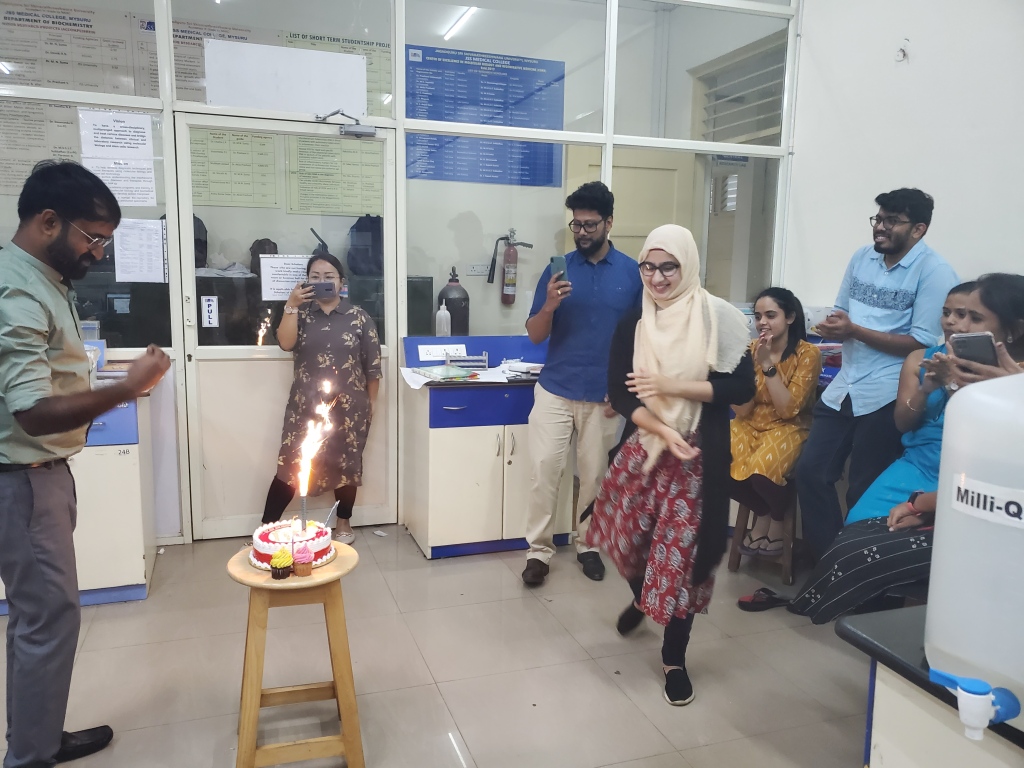
WEDNESDAY
Today, the other interns and I had the opportunity to shadow Dr. Vijaya during a clinic visit. The patient had come in from KR Hospital, a nearby government institution with which PHRII shares a MOU (Memoriam of Understanding) so that patients will be referred here for the various research projects PHRI currently conducts.
Upon arriving, the patient first had a consultation with Rashmi, who collected demographic information, including her age, occupation, past smoking/tobacco use, and reproductive history (age at first period, previous abortions, number of children, HIV status, etc.).

Apparently, this patient had met with a local doctor in her community due to extreme pelvic pain and discomfort. Without providing her with much information, the doctor referred her to KR Hospital, where they again did not confirm the diagnosis to the patient, but ran a MRI. Once the MRI confirmed that the patient indeed had cervical cancer, the oncologist then sent her to PHRI for sample collection prior to her radiation or chemotherapy treatment. Rashmi and Dr. Vijaya later explained that sometimes this is due to the family’s discretion, as the don’t want the patient to endure further emotional/mental distress from the diagnosis. Other times, the physicians just end up passing along this responsibility, hoping that the other specialists will break the news. This was quite surprising to me, because I imagine that a diagnosis as life-changing as cancer would warrant almost immediate notice so that the patient can make the best-informed decision. It’s unthinkable how even after being referred to so many health institutions and going through so many tests and procedures that no one even gave the patient the respect of at least informing her of her condition. It reminds me a lot of The Farewell, a film that Awkwafina starred in featuring a similar story of an elderly grandmother whose family decides to keep the information of her cancer diagnosis from her for her peace of mind, much to the protest of her ABC granddaughter, Billi. There’s a line that Billi’s uncle mentions in this movie, “You think one’s life belongs to oneself. But that’s the difference between the East and the West. In the East, a person’s life is part of a whole. Family. Society.” Maybe it’s a similar phenomenon here and it’s inappropriate of me to impose this Western perspective of individual autonomy into this context, but I can’t help thinking just how unfair it is to lie by omission to someone, especially when it deals with a topic as vital as life and death.
WARNING. medical descriptions ahead, skip to THURSDAY if squeamish
After the consultation with Rashmi, the patient then went in for a pelvic examination with Dr. Vijaya. Leona, Samhita, and I were able to rotate and observe this procedure, with the patient’s consent. Dr. Vijaya first inserted a speculum that resembled a reverse clamp. Instead of holding things shut, this device opened up the vagina, allowing a clearer and unobstructed view. The first sample was the CVL, or Cervical Vaginal Lavage. During this, Dr. Vijaya first applied saline to the cervical region and waited for one minute. The saline was then removed using a pasteur pipet and placed into a sterile tube. From my conversations with Anisa, the CVL sample will likely be used in Medha’s PhD project examining metabolites, cytokines, proteins, and bacteria in cervical cancer patients.
The next steps were to collect the the LBC (Liquid Based Cytology) and HPV test samples. Since Anisa and I had previously conducted LBC staining in the lab, it was intriguing to see the sample collections stage that occurs prior. During this procedure, Dr. Vijaya inserted a plastic scrub-like swab apparatus. This test apparently replaces the pap smear, as the LBC staining that occurs greatly improves the clarity and contrast of the sample, facilitating the diagnosis that the pathologist will have to conduct in the future.
I’m really grateful I had the opportunity to shadow this patient interaction. Working in the lab, where patient samples are reduced to mere letters and numbers, it can quickly feel impersonal, and it’s easy to forget that each sample we process and collect belongs to a person. Especially since my project pertains to cervical cancer, it takes on a lot more meaning when you recognize that the individual who the sample belongs to likely had to overcome a myriad of emotional and physical challenges prior to and in the aftermath of their diagnosis. It really put things in perspective, and it was both sobering and humbling to witness this small part of the patient’s care.
THURSDAY
This morning, Leona and I went to Chamundi Hills for a morning hike before work. We initially hoped to climb the 1008 stairs up and down but accidentally input our destination on Uber as the Sri Chamundeshwari temple at the peak. Because of the additional time we had though, we were able to enter inside the temple, where they were conducting a variety of religious ceremonies. Even though we entered mere minutes after the temple opened at 7:30am, there was still an enormous crowd of people. There were also so many monkeys perched on the roof of the temple and in the trees next to the stairs. Since the temple receives so many visitors, I’m assuming that these monkeys have lost any innate fear of people which can lead to some unexpected encounters with unsuspecting tourists like ourselves.
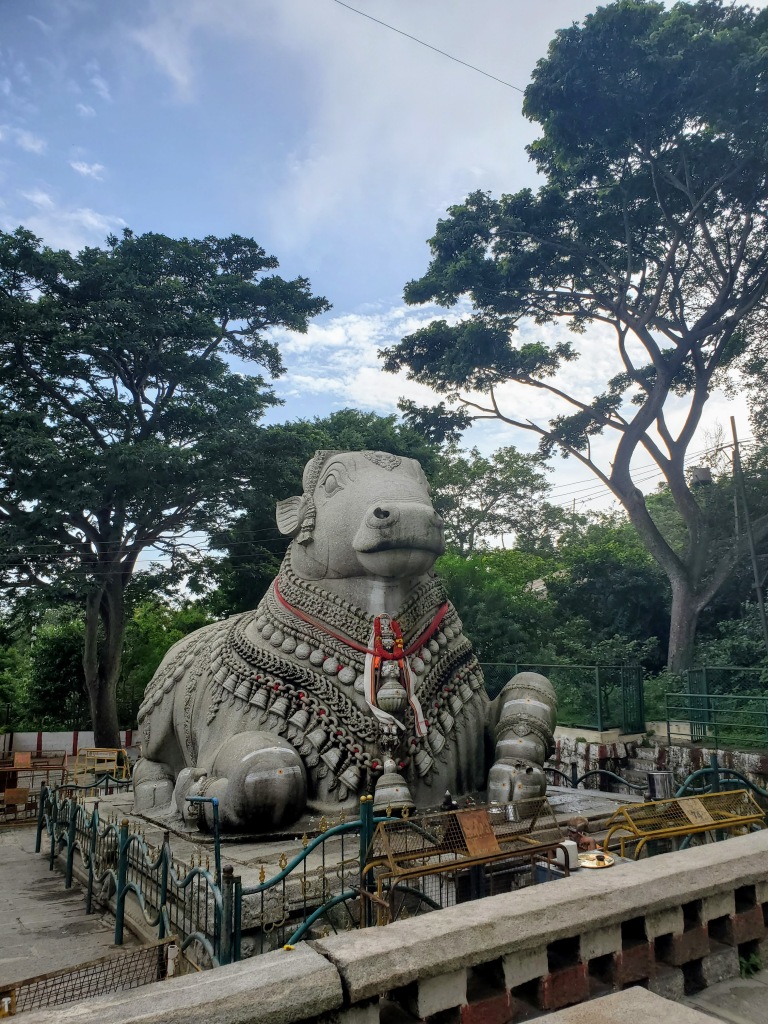

monkey 

In the afternoon, I went to JSS to shadow Medha as she performed the RNA extraction from serum using the trizol method. Even though she had already run this method in the past, we wanted to see whether a higher initial concentration of serum would result in greater RNA concentration and purity. I will have to return tomorrow to continue this process since there is an incubation step overnight. By then, hopefully there will be a pellet precipitate that we can extract the RNA from.
I also had lunch at JSS today (rice bath), where I met a few other PhD students also in the CEMR Department. They were all so welcoming and offered a few restaurant recommendations around Mysore. They have this practice where each person will share a bit of the food they brought from home, which I found incredibly wholesome. Through my conversation with Kruthika, a first-year PhD student, I also learned that American TV shows are much more well-known here than I thought. Besides the obvious contenders like The Office and Friends, everything from reality TV (Keeping up with the Kardashians), medical procedurals (The Good Doctor), and even historical dramas (The Crown, Bridgerton) are commonly heard-of.
FRIDAY
Since Dr. Karl’s arrival yesterday afternoon, everything at PHRII seems much more purposeful. Anisa and I met with him this morning to discuss the developments in the microRNA project. It looks as if we need to purchase a lot more supplies to standardize our procedures and make sure the experimental conditions are as ideal as possible.
A few takeaways from this meeting:
Recognizing my limitations. As an undergrad research assistant, there’s a lot I don’t know and a lot that I can’t do (yet). Dr. Karl pointed out that since I’ve only had a few months experience rigorously working in a wet lab prior to coming to India, it would likely be best if Anisa carried out the pipetting just so the workflow would be as accurate as possible.
Differences in leadership. Dr. Subbarao (the JSS professor who I work under in India) and Dr. Karl have vastly different approaches to spending. For the last month, the impression I received from Dr. Subbarao was to work with what JSS already has, minimize costs, and be mindful of budget constraints. Since I had no knowledge of where the funding for this project was coming from, I assumed that JSS and Dr. Subbarao controlled the financial aspects. Even when I brought up purchases such as RNAse Zap, a decontaminating solution that would eliminate RNAse enzymes to maintain more sterile RNA working conditions, and RT-qPCR or Qubit kits specially designed for microRNA, there would be an acknowledgement of the limitations posed by our current experimental conditions, but the general consensus still came to be that it was simply too difficult or too expensive to run things as they are in the United States. As someone unfamiliar with the cultural and authoritative hierarchies, I didn’t want to appear disrespectful and impose the methods and equipment I was familiar with if it would pose too much of a burden on the established system here. So, we settled. Instead of working with RNAse and DNAse free pipet tips and microcentrifuge tubes, we worked with tips that were autoclaved twice. Instead of a bleach + ethanol + RNAseZap combination to clean surfaces and equipment, bleach solution and 70% EtOH spray sufficed. Now, with Dr. Karl expressing frustration at the slow pace of the study, something which I harbored similar concerns but chalked up to “that’s just the way thing’s are in India,” it’s defeating and frankly frustrating to see tasks that could have been completed prior to my arrival only be accomplished now.
It feels as if I’ve wasted an entire month here in India. I was so scared of appearing too brusque or falling into the abrasive American stereotype, that I deferred to everyone else. Now, I see that this wasn’t the right approach. Honestly though, what was the right approach?
SATURDAY
Today was the first day of the JSS Workshop on Cytogenetics, Cell and Molecular Biology Techniques. Hosted by JSS Hospital and organized by Department of Science & Technology (DST) STUTI, the event invited MSc students, PhD scholars, faculty, and other research fellows from all over India to learn about developments in genetics/MCB research and gain hands-on experience in laboratory procedures. The workshop began with a welcome ceremony, which included an invocation song, gifting of the workshop manuals to administrative officials (JSS AHER principal, Biochemistry department head, JSS director of research, etc.), and the lighting of a ceremonial lamp. I, for one, was not expecting that this workshop would be this significant that it would receive so much attention and fanfare.


After the workshop ended around 6:15pm, I went to the Mysore palace to meet Nikhita and Priyanka. We were hoping that the palace would be illuminated that evening, but with PM Modi arriving the next day for International Yoga Day, they canceled the palace lighting and cordoned off the entrances. Before heading back to PHRII, we had dinner at Hotel RRR, a restaurant near the Mysore Palace. It was really nice to finish the week on a high note after a stressful few days.


-
third week
This week, all the other interns have officially arrived! Leona is a Neuroscience and Performance Arts major from Brown who is incorporating her doula work and emotional support peer coaching experience into a training for ASHA workers. Samhita is a Public Health and MCB major from UC Berkeley. Her project is focused on conducting an impact evaluation of PHRII’s cervical cancer screening program, where she will be interviewing ASHA and Anganwadi workers on community receptiveness and the efficacy of the program.
Since I was unable to start lab work on Monday due to Dr. Subbarao being on leave, I was free to accompany Ambika, one of the counselors at PHRII, and Nikhita to recruit patients at a rural Primary Health Center (PHC) for her project examining quality of life for young adults with diabetes. We were brought to a small office where the nurse and one other hospital personnel combed through handwritten ledgers of patient names for individuals who fit the eligibility criteria. It was really fascinating to see how they still use paper records, especially when everything is so digitalized in the US.
As a side note, I have also fully recovered from food poisoning! Monday night, Samhita, Nikhita, and I ordered Domino’s off of Swiggy (a food delivery app). I’ve never had anything quite like Indian pizza before (e.g. the magherita pizza even had mayonnaise). It was one of those things were I was ambivalent, neither liking it or hating it, but I don’t think I’ll be ordering it again anytime soon.

Domino’s (india ver.) TUESDAY
I was finally able to start RNA isolation on the samples today!! Even after completing two weeks of this internship, it’s still an adjustment becoming more familiar with the cultural/workplace differences in sense of time. For instance, being told on Saturday that we could begin the lab procedures on Monday and then not being able to start until today certainly takes getting used to. I think it’s a very American or perhaps just a personal preference way of working that everything needs to be as efficient as possible. It’s common to value productivity and results above all else, but here, it’s normal and almost expected for things to go awry. I’ve learned that it’s often helpful for my sake and others’ to reiterate myself more than once, but it’s also definitely good practice to make sure that everyone has everything they need, be considerate to everyone’s needs and the pace at which they work at, and to slow down and consider every detail. A lot of the things that we take for granted in the US such as nitrile gloves and wet ice and accessing molecular grade ethanol and isopropanol in a lab require much more forethought and planning than I assumed. During this internship, I’ve also learned to be much more self-sufficient. Even with the backing of amazing mentors like Dr. Purnima and Dr. Zhou, sometimes it’s just quicker and easier to spend the time researching the answers to my queries than it is to articulate my thoughts precisely in a well-worded email that strikes the balance between appreciative and self-sufficient while recognizing my own limitations as an undergraduate research assistant.
I find myself yearning for guidance though. At least in my experience, it is typical for most PIs to have a lab manager whose full-time job is dedicated to maintaining the lab, part of which entails training undergraduate students. In Dr. Zhou’s lab, I was fortunate that Tasha (my lab manager) was such a good teacher who constantly took the time to explain lab procedures to me, answer my countless questions, and invite me to shadow and eventually take part in the variety of projects, ranging from shadowing sheep necropsies to reading mice pap smears under a microscope to identify estrous stages. It was because of her guidance that I learned so much in such a short amount of time. Even when things with my miRNA project were going slow, there was no shortage of things to do, to learn and perfect. Here, the culture is a lot more different though. Everyone in the lab is a PhD student, tirelessly working to complete their degrees. Consequently, the time they have to mentor undergrads, especially undergrads who are only there for a short amount of time, is incredibly limited. From a cost-benefit analysis, it makes sense. Why would you pour so much time and effort into someone when you won’t get much return out of it? It’s tough to constantly remind myself to seek out help, that it’s not that other people are unwilling to help but just that they may be too busy to think of offering help. It scares me to be so direct, but I think it’s also necessary for me to take initiative and directly ask for guidance if I want to get the most out of this internship.
WEDNESDAY
Thanks for listening to (reading??) my TED talk yesterday. In the morning, Anisa and I headed to JSS Medical College to discuss with Dr. Subbarao about the next steps of our project, which will be to run the cDNA synthesis and RT-qPCR with the RNA samples we isolated yesterday. Since Medha was occupied with her other research today, and the reagents and equipment we need for these procedures are only available if she’s supervising us, we returned to PHRI soon after.
The rest of the day was mainly spent organizing samples in the -80 freezer, which is much more packed and cluttered than the -80 freezers I’ve encountered before. Since the organization system was very minimal, it was incredibly difficult to locate the specific age-matched, control group samples we are supposed to process first. To make it easier in the future for us to quickly access the samples we need and avoid freeze-thaw cycles that will destroy RNA, I labeled the lids of the 400+ sample tubes and placed them in numerical order. To be honest, this task was quite therapeutic.
For dinner, Leona, Samhita, Nikhita, and I went to High Park, a rooftop restaurant with a revolving deck. As we ate, we were able to see the sunset over the Mysore skyline. Despite the unorthodox music choices (i.e., the Office theme song), it was still an enjoyable experience., and a restaurant I would return to again.

High Park views 
pt. 2 THURSDAY
This afternoon, I was supposed to go to JSS Medical College to perform cDNA Synthesis from the RNA samples we isolated earlier this week, but Medha was unable to make it due to an emergency at JSS Hospital, so we’ll have to postpone the procedure to later.
With my schedule then free, I was able to help Maiya clean up data for a COVID-19 vaccine hesitancy survey PHRII had conducted along with the other interns. Over the course of a year, PHRII had collected over 507 responses, making this the largest Excel spreadsheet I’ve ever worked with. For each question, we had to write out all the possible responses and convert all the selections to 0’s and 1’s. This was a very eye-opening seeing just how much work goes into qualitative studies. With the very limited prior knowledge I had, I thought that recruitment and survey distribution took up the bulk of a public health/epidemiological study, but they’re really only small pieces of a much larger puzzle. I find qualitative studies so unique because they tell a story though. In lab research, these stories are often so inaccessible because everything’s so zoomed in on minute details and changes, but qualitative research often presents findings that the lay person can understand and find meaningful., lowering the barrier of entry. There’s much more opportunity to take initiative and agency of your own project and design it to tailor your academic interests and what you find along the way. With wet lab research, purchasing reagents and making small tweaks to the protocol don’t necessarily yield immediate results, and it can feel incredibly monotonous. With qualitative research though, it’s easy to see the applications of your research, which honestly just makes it more personal and rewarding and definitely something I would want to do more of in the future.
After work today, I attended a yoga class! It was held at a place called Yoga Gita in Gokulam, a neighborhood that I recognized from previous interns’ blogs as a yoga hub for Mysore. This was my first time with any structured group yoga/exercise session, and I didn’t really feel like I knew what I was doing most of the time, but the instructor was incredibly patient and encouraging. The class was super calming and peaceful, and I walked away feeling very refreshed.
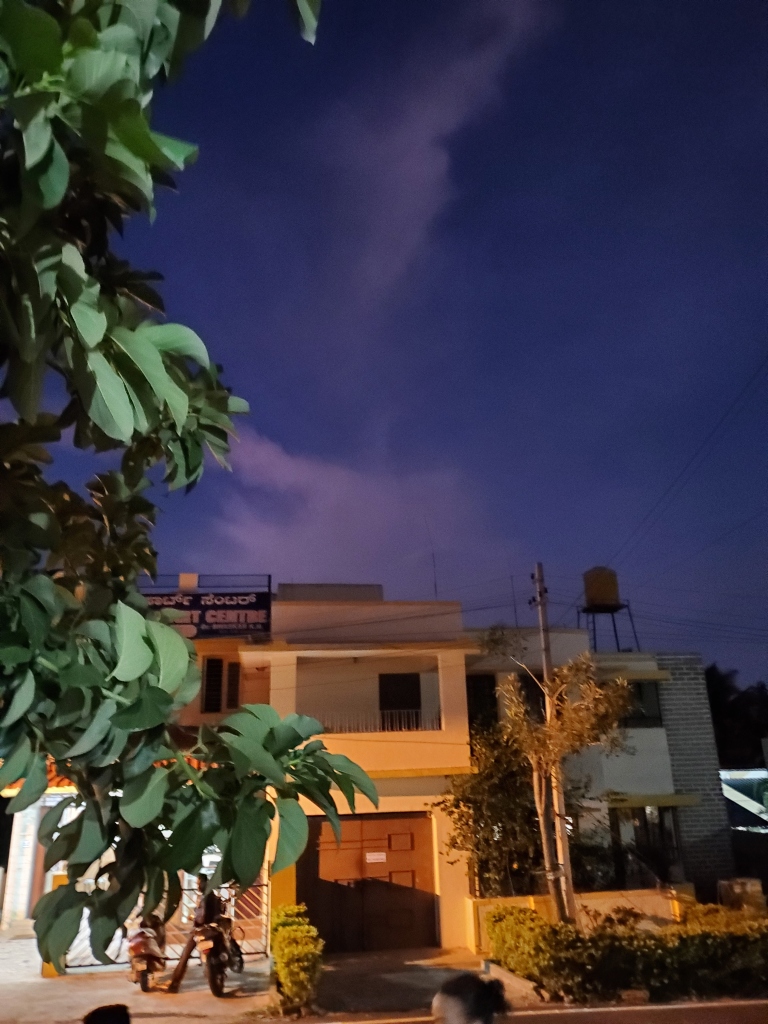
purple sky FRIDAY
PHRII organized a haldi ceremony for Maiya today!! Since she’s engaged and will be getting married a few months, the ceremony is meant to bless the couple and consisted of traditional rituals, mehndi, and dancing to Bollywood and Kannada music. It was so lovely that the staff at PHRII organized this for Maiya, and the whole experience was a beautiful example of the “second family” atmosphere here. After, Priyanka, Maiya, and I departed for Coimbatore (Priyanka’s hometown) to celebrate Priyanka’s birthday.

WEEKEND
On Saturday, we traveled to Kotagiri with Ghita, Priyanka’s sister. Kotagiri is primarily known for its waterfalls and tea plantations, and the drive there was populated by monkeys perched on the highway barriers.



Ghita and Priyanka’s relationship is so wholesome. Ghita is clearly the more adventurous one, repeatedly asking multiple locals if we could trek down to Catherine Falls even though each one reiterated that the trail was now closed. Priyanka prefers to play it safe, preferring to not “risk her life”, as she says. Even on the drive there, Ghita deftly navigated hairpin turns, passing drivers even when confronted headfirst by cars on the opposite sides multiple times.

birthday celebrations!! 
saree shop,, so colorful! We also got to meet Priyanka’s nephew, who is barely learning to crawl now, along with Tinku and Tiger, Priyanka’s dogs that enjoy stealing her nephew’s toys. This weekend trip was so enjoyable, and Priyanka’s family was incredibly hospitable. Maiya and I both ate so much food, and I’m really glad I had to the opportunity to see another part of India!!
-
second week
Hopefully, it’s nothing too serious. Famous last words.
I’ve fallen sick to food poisoning. Yippee. I’ll spare you the details, but my updates this week will be brief.
Monday 5.30
As all the PHRI staff were coming in for work around 9:30am this morning, we kept on hearing drumming outside. Rashmi informed everyone that there were film crews shooting a Bollywood movie down the street by the dhobi ghat, so we all rushed to see. They were apparently filming a funeral scene, as we could see a “body” wrapped in white cloth surrounded by incense and flowers. While we waited for them to begin, Priyanka explained that funeral rituals in India often involve a grand procession in the streets. Off to the side, there was parked SUV from which the lead actor – Nivin Pauly – later emerged. After 30 minutes, Mrs. Jay sent Siddhu to call everyone in. Even though we didn’t actually see any of the film shooting take place, it was definitely an exciting start to the day.

funeral scene (if you zoom in, you can see the “body” wrapped in white cloth behind the bike) 
film crews In terms of project updates, Anisa and I went into the lab again on Tuesday and Thursday to isolate RNA samples from serum again, but this time with a modified protocol that included on-column DNAse I digestion and additional wash steps. This SOP was based off the one we used in Dr. Zhou’s lab, but since we’re still waiting for the Qiagen kits to arrive, we had to do with what we could using lyophilized DNAse I powder from JSS without Buffer RDD. It still doesn’t look like our RNA quality is where we want it though, so we’ll have to continue to modify the SOP.
Wednesday 6.1
On Wednesday, Maiya arrived! She’s a PhD student from the University of Arizona studying Health Behavior Health Promotion in Priyanka’s cohort. While at PHRI, she’ll be helping perform qualitative and quantitative analysis of the COVID-19 vaccine hesitancy study PHRI conducted over the past year or so.
Today, I also met Divya and Nimitha, MPH students from JSS Medical College. They’re both trained in dentistry but studying public health. Their work at PHRI will mainly consist of conducting IDI (in-depth interviews) of women in the surrounding villages to assess social support systems during menopause.
With so many new faces, Anisa gave us an orientation today about PHRI that introduced its history, past projects, and current involvements. Mrs. Jay also joined, and we discussed the variety of support networks, both government-funded and NGOs, that exist in the Indian healthcare system. Apparently, for every 1,000 people, there is an assigned ASHA (Accredited Social Health Activist) who is selected from the community to serve as the first point of contact between villagers and the healthcare system. ASHA workers are typically tasked with promoting public health initiatives (e.g. immunizations, clean water, nutrition, basic sanitation and hygiene, reproductive counseling, child health, etc.) and receive some training to deliver basic first aid and vaccinations. Besides ASHAs, there are also Anganwadi centers for every 1,000 people that exist in both urban and rural areas. These government-sponsored programs essentially exist as preschool and community health centers all in one. Through AWW (Anganwadi workers), the government works to combat childhood malnutrition by providing meals for children that include grains, vegetables, and one egg a day so they receive sufficient protein intake. Children under 3 years old are weighed monthly to keep track of their health, and AWW also provide health education to young mothers through home visits and demonstrations.
For PHRII, the AWW and ASHA workers serve as an intermediate to engage the community in research. Prior to going into a village, one of the PHRI counselors/outreach workers will contact the AWW and/or ASHA worker in the morning, who will then recruit in their respective communities to find participants that fit the eligibility criteria of the current study.
Thursday 6.2
Today, Anisa had to process patient blood samples to test their hemoglobin, LDL, cholesterol levels, and other markers, and she volunteered to run a blood panel for me too. We had Rani, the staff nurse, collect 5 mL of my blood, after which we are able to proceed with the various tests. Even though I’ve had blood tests in the past, it was a strange experience processing my own blood and seeing the results in real-time.

Sri Ramakrishna Ashrama After work, Maiya, Priyanka, and I stopped by Sri Ramakrishna Ashrama on the way back from the supermarket. The architecture was stunning, and the altars inside the meditation space were incredibly well-maintained.
Friday 6.3
On Friday, I was able to go along with Nimitha and Divya as they conducted their interviews in the community. We visited an Anganwadi center, that I initially assumed was a temple because of the sculptures of cows on the roof. Inside, the walls were decorated with colorful paintings of English and Kannada vocabulary words, numbers, and Indian historical figures. Divya and Nimitha explained that the artwork is actually mandated by the government.
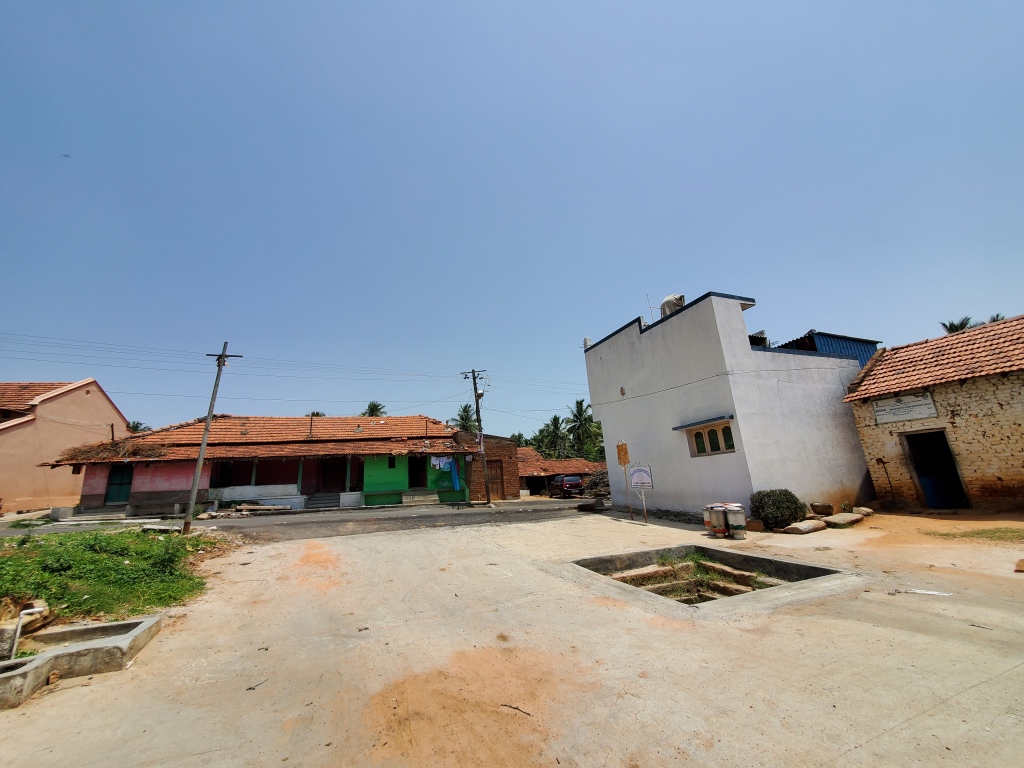
village (0.5x) 
Anganwadi center 


kiddos While they conducted their interviews outside the Anganwadi center, Dakshayini (the PHRI outreach worker) and I explored the KRS backwaters nearby the village. The villagers often wash their clothes in this river, so there were a few stray socks lying around the riverback. On our way back, we encountered a stubborn cow that Dakshayini (unsuccessfully) tried to scare away with a stick for a few minutes, after which it thankfully meandered away.

Nimitha + Divya 
stubborn cow It was honestly really exciting to see how an Anganwadi center operates. It surprised me to learn that even in a lower/middle-income country like India, its healthcare system seems much more progressive than in the US. Despite its flaws, there appears to be at least government support for the health and well-being of its citizens in that there exists a framework to allocate resources and provide perinatal care for both the mother and child. A program like this would likely be lambasted as too socialist in the United States, but the efforts AWW and ASHA workers are involved in honestly just provide basic necessities and care that all people deserve, regardless of socioeconomic status. It’s disheartening to see that something so commonplace in India – this respect for children and mothers and the willingness to provide for their well being – isn’t the case in the United States. Nevertheless, it is still fascinating to see how allied health and healthcare systems operate in different parts of the world.
WEEKEND 6.4 – 6.5

On Saturday, Maiya gave the PHRI staff a presentation on Qualitative Codebook Development and Coding. From the title, I assumed that we were going to learn about basic Python skills, but it turns out that coding has an entirely different meaning in qualitative research. Even though I knew the difference between qualitative and quantitative data, apparently, there’s also qualitative and quantitative methods and interpretation in research. Also, there’s so much work that goes on in qualitative research beyond conducting interviews and distributing surveys than I expected. I had no idea that this much work goes on behind the scenes in public health research, and this internship has definitely been great exposure to explore what other types of research exist.
-
first week
Monday 5.23
THERE’S A LIZARD ON THE CEILING. oh my heck I don’t know what to do. I went to close the blinds, and it appeared out of nowhere.
It’s fifteen minutes later, and it finally scampered away. Thank goodness.

new lizard friend that I hope never returns Amphibious visitors aside, today was actually pretty productive. This morning, Anisa and I visited the CEMR (Center of Excellence in Molecular Biology and Regenerative Medicine) lab at JSS Medical College where I will be conducting the bulk of my lab work this summer. There, we ran the lab protocol to isolate miRNA from serum samples using the Qiagen miRNeasy kit. I also met Medha, the PhD student at JSS tasked with the miRNA project. For lunch, Kavitha, Anisa, and I stopped at the canteen for dosa, which was only 45 rupees and pretty tasty – much better than the food they served in my school cafeterias.

JSS canteen Here’s a few things about labs here that surprised me:
- Lab coats are only reserved for medical students. PhD scholars and MSc students are not permitted to wear them in the lab. Anisa told me that white coats grant certain privileges to the MBBS students, such as not being pulled over by the police. I was later informed that even though PhD students have petitioned in the past to wear lab coats, there is some rule at JSS that only allows MBBS students to wear them.
- Nearly no one wears closed-toe shoes in the lab. While some students will wear sandals with stockings, others have a designated pair of flip-flops they’ll wear in the lab. With all the molecular grade and hazardous chemicals in the lab, it’s definitely surprising how relaxed the safety guidelines seem.
- Limited stock of gloves. In the US, it seems like gloves are in never-ending supply. Here, it’s vastly different. According to Anisa, each PhD student is responsible for procuring their own lab supplies (e.g. pipets, pipet tips, ethanol spray, paper towels/tissue paper, nitrile gloves, stationary, etc.). As a result, resources are fiercely rationed and gloves are frequently reused. This is definitely a stark contrast to how I’m used to operate in US labs, and it makes me wonder how much more difficult it is to produce the same level of high-quality and reproducible research in conditions like these.
Tuesday 5.24
Today, Medha had some other work she needed to take care of at JSS, so Anisa and I weren’t able to go to the CEMR lab. Nevertheless, we were able to spend some time in the lab here at PHRI processing LBC (liquid-based cytology) samples.When patients come into the PHRI clinic or participate in one of the medical camps PHRI hosts, the physician will collect a sample of the cervix using a plastic brush. The brush is suspended in solution and kept in 4 degrees until they are processed by the lab.
Unlike conventional pap smears, LBC involves a variety of washing and staining steps to suspend the cervical cells from the sample and produce a thin, uniform layer. This greatly improves the clarity and contrast of the sample, facilitating cytological examination and reducing the possibility of erroneous diagnoses on the pathologist’s part.
After work, Priyanka and I headed to Devaraja Market, a series of stalls in Mysore known for selling ever kind of Indian spices, herbs, produce, and clothes. The vendors we visited sold more clothes than anything else though, but I was able to pick up a few grapes, mangos, and mosambi to fix my fruit craving.

taken near Devaraja Market. I’m not sure why the sky is purple, but it’s pretty Wednesday 5.25
Today, Anisa and I went to JSS Medical College again to conduct the cDNA synthesis and RT-qPCR with the RNA samples we isolated earlier this week. This was my first time running these processes, since I had only performed up to RNA isolation in Dr. Zhou’s lab. Even though I generally knew about these procedures in theory, it was still fascinating to observe the process carried out in real-time and see the variety of components that go into formulating quantitative outputs about gene expression from the RNA we isolated. This was a lot to process though, and I expect I will have to spend the next few days to understand all the dilution calculations and rationale behind RT and RT-qPCR.
Also, animal-shaped trash cans are a thing here. When I came to JSS on Tuesday, I noticed that there were quite a few penguin statues scattered around the campus and assumed that penguins were the mascot of JSS or that some higher-up was a penguin fanatic. The much more reasonable explanation, as I found out today, is that the penguins are wastebaskets. I’m still not sure why regular-shaped trash bins don’t suffice, but the penguin-shaped ones certainly spice up and serve as a lively addition to the walkways and corridors

penguin numero one 
penguin numero two The jet lag is also hitting me pretty hard right now. By the time work finishes (around 5pm), I’m feeling pretty sleepy so I end up taking a nap and waking up around 7-10pm. I don’t end up falling back asleep until around 1am though, so my sleep is all in segments.
Thursday & Friday 5.26 – 5.27
I mainly spent the next few days in the lab at PHRI researching cDNA synthesis and RT-qPCR. Even though Medha was a great teacher in explaining these processes yesterday, I thought it would still be helpful to go through them myself to understand each step.


PHRI lab Although note-taking and watching Thermo Fisher videos is tedious and not as exciting as bench work, it brings its own sense of fulfillment when you’re finally able to grasp a concept or work out a confusing calculation. I think one of the most gratifying things about research is this sense of agency. There’s no one forcing me to research cDNA synthesis or RT-qPCR nor will I be tested on this content in an exam – it’s purely for my own sake, for my understanding so that I’m more well-versed in this topic and can contribute in a greater capacity in my lab work.
No matter how I put it though, it’s most definitely monotonous work, and I can’t wait to get back into the lab next week.
For dinner Friday, Priyanka and I stopped by Casino Park. Per the intern guide, they’re known for their chicken kabob and shawarma, so we ordered those dishes accordingly along with their kerala parotta, coin parotta, and butter chicken. The food was a bit overpriced though and nothing special, in my opinion. We were able to see a few cows as we were walking through the streets though. Another thing I’ve noticed about Mysore is how pretty the sky looks in all my photographs, definitely a plus.

cows and autos. a typical scene Saturday & Sunday 5.28 – 5.29
On Saturday, I walked to Loyal World by myself. It was a bit stressful navigating the streets of Mysore armed only with Google Maps to guide me. Here, the autos and two-wheelers zip by at terrifying speeds and it’s a bit like playing Crossy Road but in real-life. I made it to the supermarket all in one piece though and bought a few snacks and bananas.

Kalidasa Road On Sunday, I stopped by a Greenleaf, a restaurant recommended on the intern guide for good veg options located on Kalidasa Road. I saw a video posted by Beryl Shereshewsky featuring gobi manchurian – a dish of fried cauliflower doused in a spicy, sweet chili sauce – so I wanted to try it out for myself. Along with gobi manchurian, I ordered the burnt garlic fried rice and mango juice. This was my first time trying Indochinese food, and it’s definitely not like anything Indian or Chinese I’ve ever tasted. The gobi manchurian was pretty spicy though, so I was glad to have the mango juice to wash everything down.

Greenleaf interior. Note the sign. Eat kulfi, everyone. On the way home I was feeling a bit dizzy though and my stomach started hurting a little later that night. Hopefully, it’s nothing too serious.
Overall, it was a pretty successful first week, and I’m grateful to have learned so much. Huge thanks to everyone at PHRI for making the transition to working in a new country so smooth. I’m looking forward to continuing work on the miRNA project next week and exploring more of Mysore.
-
familiar yet foreign
Reflections from my first weekend in India (May 20 – May 22, 2022)
After roughly 24 hours of travel, I have finally arrived in India! Special thanks to Priyanka, a PhD student at the University of Arizona and my travel companion who made sure that I was well taken care of every step of the way, much to the relief of my parents. After navigating customs and health screenings at the Bangalore International Airport, we were finally greeted by Mr. Kantharaj, who drove me the 3.5 hours from BLR to the Public Health Research Institute of India (PHRII), where I will be working for the next two months. While waiting for Mr. Kantharaj to pull his car around, I was struck by the symphony of sounds. Even at 4:00 am, honking cars and cawing ravens signaled a warm welcome.

BLR at 4:00am. If you look closely, you can see the stray dogs. Despite my best efforts to stay awake during the drive to PHRII, I found myself drifting in and out of sleep. Every time I woke up, the scenery would change; the sky becoming lighter and the landscape becoming more rural by the hour.
With that, here’s a few things I’ve noticed about the roadways in India:
Honking. So much honking. The drivers here are definitely much more liberal with their horn than those back in the States. Likely due to the lack of stop signs and traffic lights, at least on the roads I’ve been on, drivers honk prior to intersections and pretty much whenever they feel appropriate (which is incredibly frequent), signaling to nearby vehicles their presence. Here, some trucks even have bumper stickers welcoming other cars to honk at them.
Mario Kart-esque rides. Besides the non-stop honking, the autos/rickshaws here also dodge a wide array of obstacles, ranging from cows to zigzagging scooters. “Personal bubbles” and “space cushions” do not exist in this precarious realm. As someone who gets nervous driving in downtown Phoenix, this was truly a terrifying and unorthodox way to travel but effective nevertheless.
The scenery on the drive to PHRII reminded me a lot of the other countries I’ve visited. The painted buildings reminiscent of the colorful houses in Agua Prieta, Mexico while the lush greenery, shuttered storefronts, humid weather, and even the paved sidewalks were similar to those in Taiwan. Other times, the landscape was completely different than anything I’ve ever seen – the sheer amount of people walking in the streets, Hindu temples, gated hospitals and municipal centers, the multitude of animals ranging from cows to peacocks nonchalantly existing alongside bustling crowds. In moments like those, I could only soak in the scenery and marvel at the differences. I imagine there will be a lot of these moments on this trip.
After reaching PHRII, I was introduced to the security guard Siddhu, who graciously helped me bring my luggage to the upstairs dorm where I will be staying. At 9:30 am, I met Teju, the office supervisor, who gave me a tour and promptly introduced me to a flurry of individuals who work at PHRII. Everyone was incredibly friendly, and I feel bad that I only caught the names of a few people. While eating breakfast – a South Indian dish called idli served with chutney and a potato curry – Mrs. Poornima Jay (the PHRII administrator) gave me a summary of the expectations and details of my internship. I also briefly spoke to Dr. Vijaya and Dr. Kiran about the miRNA project I will be working on for the next two months.
Around 10:30am, I retreated back upstairs and ended up taking a 7-hour nap. I am never underestimating the power of jet lag ever again.
Saturday and Sunday, I mainly spent the weekend orienting myself to the sights and sounds of Mysore. Interestingly enough, Saturday is also a work-day in India, although thankfully a shortened one. Teju took me to Loyal World, a supermarket stocked with essentials ranging from shampoo to spice mixes. Even though it was smaller in size, it did remind me a little of the Costco warehouses back home. I even needed to have my receipt checked at the door, albeit without the cartoon smiley faces drawn in highlighter.
Living at PHRII is also a bit lonelier than I thought it would be. The other interns won’t be arriving until June 6th, and with Priyanka staying in an apartment farther away, it does get isolating at times. Once all the PHRII staff leave for the day, the house becomes a lot quieter. Even though Siddhu, Lakshmi (the housekeeper), and their family keep me company, our interactions are fairly limited. They’re both incredibly sweet and thoughtful though, with Lakshmi even bringing up my breakfast Sunday morning: ragi roti served with chutney and a concoction of curry leaves, onions, peppers, and tomatoes.

breakfast I think my motto eating food in India is best summed up by “I’m not sure what it is, but it tastes amazing.” Hopefully by the end of this trip, I’ll be less clueless though and be able to both enjoy the dishes and know their names. All in all though, it certainly has been a unique experience living in a foreign country, and I’m excited to see where this internship leads next!
-
Subscribe
Subscribed
Already have a WordPress.com account? Log in now.